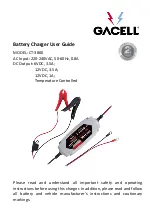
11.
DC CONNECTION PRECAUTIONS
a.
Connect and disconnect the DC output clamps only after setting the charger switches to the
OFF
position from the electric outlet. Never
allow the clamps to touch each other even with charger turned off.
b.
Attach the DC clamps to the battery post and twist or rock back and forth several times to make a good connection. This tends to keep
the clamps from slipping off the terminals and helps to reduce the risk of sparking.
c.
NEVER touch the charger leads or rock the clamps when the charger is "ON". This can break the connection at the battery and cause an
explosion.
d.
NEVER break "live" circuits at the battery terminals because it may spark. Always be sure the charger is "OFF" before removing the
charger leads from the battery.
12.
FOLLOW THESE STEPS WHEN THE BATTERY IS OUTSIDE THE VEHICLE. A SPARK NEAR THE
BATTERY MAY CAUSE BATTERY EXPLOSION. TO REDUCE THE RISK OF A SPARK NEAR THE
BATTERY:
a.
Read section "STOP/GO LITE INSTRUCTIONS" before proceeding.
b.
Check the polarity of the battery post. The POSITIVE (POS, P, +) usually has a larger diameter than the NEGATIVE (NEG, N, -) post.
c.
Attach at least a 24 inch long 6-gauge (AWG) insulated battery cable to the NEGATIVE (NEG, N, -) battery post.
d.
Connect the POSITIVE (RED) charger clamp to the POSITIVE (POS, P, +) post of the battery.
e.
Touch the contact button of the STOP/GO LITE to the free end of the battery cable. If the red light comes on, reverse the connections to
the battery and retest. When the green light come on, position yourself and the free end of the cable as far away from the battery as
possible, then connect the NEGATIVE (BLACK) charger clamp to the free end of cable.
f.
Do not face the battery when making the final connection.
g.
When disconnecting the charger, always do so in reverse sequence of connecting procedure, and break the first connection while
standing as far away from the battery as practical.
h.
A marine (boat) battery must be removed and charged on shore. To charge it on board requires equipment specially designed for marine
use.
13.
GROUNDING INSTRUCTIONS
This battery charger should be connected to a grounded, metal, permanent wiring system, or, an equipment-grounding conductor should be
run with circuit conductors and connected to equipment-grounding terminal or lead on battery charger. Connections to battery charger should
comply with all local codes and ordinances.
14.
AC POWER CONNECTION
a.
Wire to 190-262 volt single phase 50/60 cycle supply. Wiring and size must meet local and national electrical codes and carry 15
amperes.
b.
Measure the voltage across the two hot leads that will be supplying voltage to the charger.
c.
Remove the left side panel of the charger.
d.
Bring the AC wiring in through the strain relief connector in the lower right corner of the back panel.
e.
Connect one hot leg to terminal strip marked "Hot Leg". Connect the other hot leg to voltage tap nearest to the voltage measured in Step
b. If measured voltage is between two voltage taps, connect to the tap of higher voltage. Connect the neutral wire to the ground screw on
the base of the charger.
f.
Tighten the strain relief connector leaving only the minimum amount of extra wire in the charger.
g.
When connecting the charger to a charging rack, always be sure the connections are made with the correct polarity. The positive lead on
the charger is marked with red tape.
15.
MOUNTING INSTRUCTIONS
a.
Mount angle brackets securely to the wall 8-1/2
inches apart.
b.
Place charger and shelf assembly on brackets.
c.
Center shelf on brackets and screw brackets to
shelf with screws provided.
2























